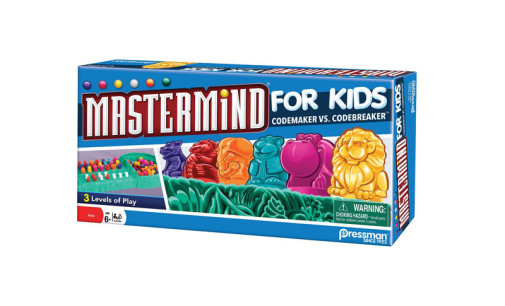We use cookies to make your experience better. To comply with the new e-Privacy directive, we need to ask for your consent to set the cookies. Learn more.
Mastermind For Kids Game
- Small parts. Not for children under 3 years.
It's the classic game of Mastermind, but reworked for a younger crowd. Where the older version uses pegs and a pegboard, this version is jungle-themed. The six colored pegs have been replaced by six jungle animals (each with a different color); the game board is the jungle floor with the storage tray/code shield shaped like a rocky outcropping. As is fitting for its age range, the code is now only three colors long, not four. Other than that, it works just like the original. One player, the codemaker, creates a code, and the other player, the codebreaker, tries to duplicate it on the board. The codemaker has white and red creature pieces which they place alongside the code, red indicating that the color and placement of the piece is correct, white indicating that the color is right, but the placement is not. Always thrilling, games are quick and scoring is simple perfect for kids. ~ Mark
Kids test their code-cracking prowess with Mastermind for Kids, the challenging game of logic and deduction. The game comes with three levels of play, so kids can learn and grow with the game. With more than 55 million units sold, Mastermind is a great strategy game . . . and one of the world's most popular games ever. It's easy to learn and fast to play, and it's different every time. The Codemaker sets a secret code, then the Codebreaker tries to match the code using logic, deduction, and maybe even a little bit of luck. After each move, the Codemaker gives clues to the Codebreaker. With lots of possible code combinations, every game is guaranteed to be a brainteaser. All of these game components can be stored in the game board. The winner will be a true Mastermind! For 2 players, ages 6 and up.
Game contents
- Plastic game base with Rocky Mountain tray
- 72 Jungle animals in 6 colors
- 15 Red scoring pegs
- 15 White scoring pegs
- Complete instructions
Can you create a code your opponent can't crack? In this classic two-player strategy game, the rules are simple; one player acts as code-maker and arranges four colored pegs behind a shield on his/her end of the board. Then it's up to the code-breaker to crack the code, guessing at the sequence of pegs the code-maker placed, and trying to duplicate it on the board. After the code-breaker places a row of four pegs, the code-maker uses small white and red pegs to give the code-breaker feedback. A white peg means that the code-breaker has chosen a peg of the right color, but it's in the wrong position. A red peg means that one of the four pegs is the correct color and in the right position. The catch is that the code-breaker has no way to know which one of his pegs is right without some trial and error! Play continues until either all ten rows have been filled unsuccessfully or the code-breaker breaks the code. The code-maker gets points for each row of pegs filled by the code-breaker, or 11 points if the code is not cracked. Then it's time to switch roles and play again. Simple to learn but challenging every time, everyone can enjoy this brain-twisting challenge.
| Product Format: | Other |
|---|---|
| Brand: | Pressman Toy |
| Grades: | 1-AD |
| EAN/UPC: | 021853030204 |
| Length in Inches: | 6 |
| Width in Inches: | 12 |
| Height in Inches: | 2 |
| Weight in Pounds: | 0.95 |

